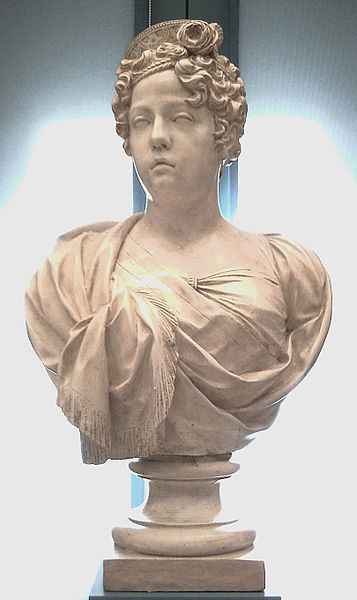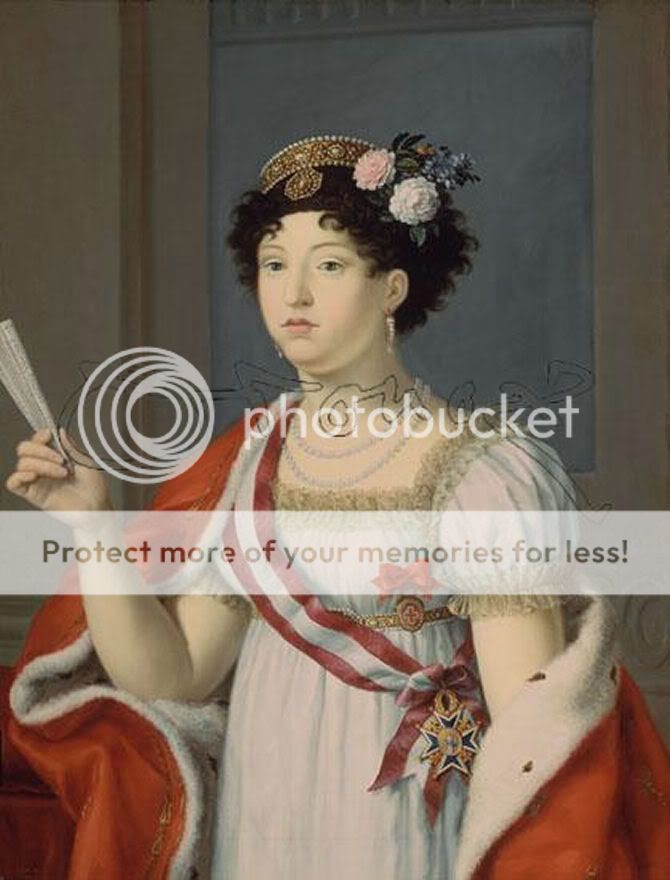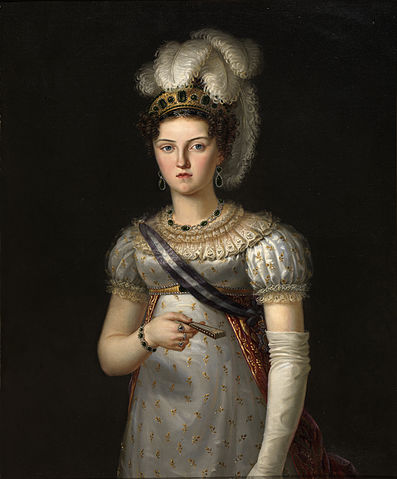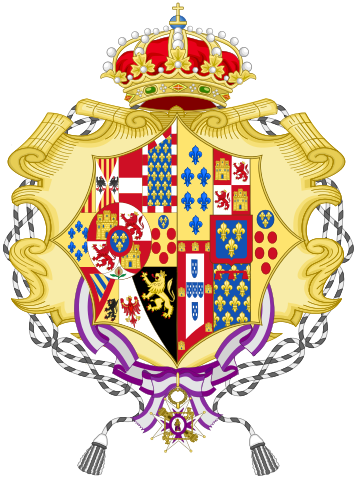- Joined
- Aug 13, 2004
- Messages
- 27,110
- City
- São Paulo
- Country
- Brazil
King Fernando VII and Wives (Queens Maria Antonia, Isabel, Josepha & Maria Cristina)
Fernando VII Maria Francisco de Paula Domingo Vicente Ferrer Antonio José Joaquin Pascual Diego Juan Nepomuceno Januario Francisco Francisco Javier Rafael Miguel Gabriel Calixto Cayetano Fausto Luís Ramón Gregorio Lorenzo Geronimo, King of Spain (Escorial, 13 October 1784 - Madrid, 29 September 1833); married 1stly by proxy in Naples, 16 Augustus 1802 and in person in Barcelona, 6 October 1802 Princess Maria Antonia of the Two Sicilies (Caserta, 14 December 1784 - Aranjuez, 21 May 1806); married 2ndly by proxy in Cadiz, 4 September 1816 and in person in Madrid on 29 September 1816, Princess Isabel of Portugal (Queluz, 29 May 1797 - Madrid, 26 December 1818); married 3rdly by proxy in Dresden on 7 October 1819 and in person in Madrid, 20 October 1819, Princess Josepha of Saxony (Dresden, 6 December 1803 - Aranjuez, 17 May 1829); married on 4thly Madrid, 11 December 1829, Princess Maria Cristina of the Two Sicilies (Palermo, 27 April 1806 - Le Havre, 13 September 1878)
Reign: 1813 - 1833
Dynasty: Bourbon
Predecessor: King Carlos IV of Spain
Succeeded by: Queen Isabel II of Spain
Children Fernando & Maria Cristina: Queen Isabel II of Spain and Princess Luisa Fernanda of Orleans & Spain
Parents Fernando: King Carlos IV of Spain and Princess Maria Luisa of Parma
Parents Maria Antonia: King Fernando I of the Two Sicilies and Archduchess Maria Carolina of Austria
Parents Isabel: King João VI of Portugal, Emperor of Brazil and Princess Carlota Joaquina of Spain
Parents Josepha: Prince Maximilian of Saxony and Princess Carolina of Parma
Parents Maria Cristina: King Francesco I of the Two Sicilies and Princess Isabel of Spain
Siblings Fernando: Prince Carlos of Spain, Queen Carlota Joaquina of Portugal, Princess Maria Luisa, Princess Maria Amalia and Prince Carlos of Spain, Duchess Luisa of Parma, Queen of Etruria; Prince Carlos and Prince Felipe of Spain, Prince Carlos of Spain, Count of Molina; Queen Maria Isabel of the Two Sicilies, Princess Maria Teresa, Prince Felipe and Prince Francisco de Paula of Spain, Duke of Cadiz
Siblings Maria Antonia: Empress Maria Theresa of Austria, Grand Duchess Luisa of Tuscany, Prince Carlo Francesco of the Two Sicilies, Duke of Calabria; Princess Maria Anna and King Fransesco I of the Two Sicilies; Queen Maria Cristina of Sardinia; Princess Maria Cristina, Prince Carlo and Prince Guiseppe of the Two Sicilies, Queen Marie-Amelie of the French, Princess Clothilda, Princess Enrichetta, Prince Carlo of the Two Sicilies; Prince Leopoldo of the Two Sicilies, Prince of Salerno; Prince Carlo Alberto and Princess Isabella of the Two Sicilies
Siblings Isabel: Princess Maria Teresa of Spain, Prince Antonio of Portugal, Duke of Beira, Emperor Pedro I of Brazil, King of Portugal, Princess Maria Francisca of Spain, Prince Isabel Maria and Prince Miguel (or King Miguel I) and Princess Maria da Assunção of Portugal and Duchess Ana de Jesus of Loulé
Siblings Josepha: Princess Maria Amalia of Saxony; Grand Duchess Maria Ferdinanda of Tuscany; King Friedrich-August II of Saxony; Prince Clemens of Saxony; Grand Duchess Maria Anna of Tuscany and King Johann I of Saxony
Siblings Maria Cristina: Princess Maria Christina of France, Duchess of Berry; Prince Ferdinando of the Two Sicilies, Princess Luisa of Spain, Duchess of Cadiz; King Ferdinando II of the Two Sicilies; Prince Carlo of the Two Sicilies, Count of Capua; Prince Leopoldo of the Two Sicilies, Count of Syracuse; Grand Duchess Maria Antoinetta of Tuscany; Prince Antonio of the Two Sicilies, Count of Lecce; Princess Maria Amalia of Spain and Portugal; Princess Maria Carolina of Spain; Empress Teresa of Brazil; Prince Luigi if the Two Sicilies, Count of Aquila and Prince Francesco di Paula of the Two Sicilies, Count of Trapani
Fernando VII Maria Francisco de Paula Domingo Vicente Ferrer Antonio José Joaquin Pascual Diego Juan Nepomuceno Januario Francisco Francisco Javier Rafael Miguel Gabriel Calixto Cayetano Fausto Luís Ramón Gregorio Lorenzo Geronimo, King of Spain (Escorial, 13 October 1784 - Madrid, 29 September 1833); married 1stly by proxy in Naples, 16 Augustus 1802 and in person in Barcelona, 6 October 1802 Princess Maria Antonia of the Two Sicilies (Caserta, 14 December 1784 - Aranjuez, 21 May 1806); married 2ndly by proxy in Cadiz, 4 September 1816 and in person in Madrid on 29 September 1816, Princess Isabel of Portugal (Queluz, 29 May 1797 - Madrid, 26 December 1818); married 3rdly by proxy in Dresden on 7 October 1819 and in person in Madrid, 20 October 1819, Princess Josepha of Saxony (Dresden, 6 December 1803 - Aranjuez, 17 May 1829); married on 4thly Madrid, 11 December 1829, Princess Maria Cristina of the Two Sicilies (Palermo, 27 April 1806 - Le Havre, 13 September 1878)
Reign: 1813 - 1833
Dynasty: Bourbon
Predecessor: King Carlos IV of Spain
Succeeded by: Queen Isabel II of Spain
Children Fernando & Maria Cristina: Queen Isabel II of Spain and Princess Luisa Fernanda of Orleans & Spain
Parents Fernando: King Carlos IV of Spain and Princess Maria Luisa of Parma
Parents Maria Antonia: King Fernando I of the Two Sicilies and Archduchess Maria Carolina of Austria
Parents Isabel: King João VI of Portugal, Emperor of Brazil and Princess Carlota Joaquina of Spain
Parents Josepha: Prince Maximilian of Saxony and Princess Carolina of Parma
Parents Maria Cristina: King Francesco I of the Two Sicilies and Princess Isabel of Spain
Siblings Fernando: Prince Carlos of Spain, Queen Carlota Joaquina of Portugal, Princess Maria Luisa, Princess Maria Amalia and Prince Carlos of Spain, Duchess Luisa of Parma, Queen of Etruria; Prince Carlos and Prince Felipe of Spain, Prince Carlos of Spain, Count of Molina; Queen Maria Isabel of the Two Sicilies, Princess Maria Teresa, Prince Felipe and Prince Francisco de Paula of Spain, Duke of Cadiz
Siblings Maria Antonia: Empress Maria Theresa of Austria, Grand Duchess Luisa of Tuscany, Prince Carlo Francesco of the Two Sicilies, Duke of Calabria; Princess Maria Anna and King Fransesco I of the Two Sicilies; Queen Maria Cristina of Sardinia; Princess Maria Cristina, Prince Carlo and Prince Guiseppe of the Two Sicilies, Queen Marie-Amelie of the French, Princess Clothilda, Princess Enrichetta, Prince Carlo of the Two Sicilies; Prince Leopoldo of the Two Sicilies, Prince of Salerno; Prince Carlo Alberto and Princess Isabella of the Two Sicilies
Siblings Isabel: Princess Maria Teresa of Spain, Prince Antonio of Portugal, Duke of Beira, Emperor Pedro I of Brazil, King of Portugal, Princess Maria Francisca of Spain, Prince Isabel Maria and Prince Miguel (or King Miguel I) and Princess Maria da Assunção of Portugal and Duchess Ana de Jesus of Loulé
Siblings Josepha: Princess Maria Amalia of Saxony; Grand Duchess Maria Ferdinanda of Tuscany; King Friedrich-August II of Saxony; Prince Clemens of Saxony; Grand Duchess Maria Anna of Tuscany and King Johann I of Saxony
Siblings Maria Cristina: Princess Maria Christina of France, Duchess of Berry; Prince Ferdinando of the Two Sicilies, Princess Luisa of Spain, Duchess of Cadiz; King Ferdinando II of the Two Sicilies; Prince Carlo of the Two Sicilies, Count of Capua; Prince Leopoldo of the Two Sicilies, Count of Syracuse; Grand Duchess Maria Antoinetta of Tuscany; Prince Antonio of the Two Sicilies, Count of Lecce; Princess Maria Amalia of Spain and Portugal; Princess Maria Carolina of Spain; Empress Teresa of Brazil; Prince Luigi if the Two Sicilies, Count of Aquila and Prince Francesco di Paula of the Two Sicilies, Count of Trapani
Last edited:





